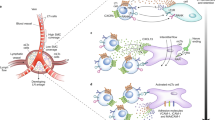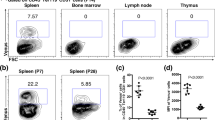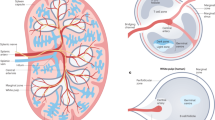Abstract
The fates of dendritic cells (DCs) after antigen presentation have been studied extensively, but the influence of lymphoid microenvironments on DCs is mostly unknown. Here, using splenic stromal cells to mimic the immune microenvironment, we show that contact with stromal cells promoted mature DCs to proliferate in a fibronectin-dependent way and that both stromal cell contact and stromal cell–derived transforming growth factor-β induced their differentiation into a new regulatory DC subset. We have identified an in vivo counterpart in the spleen with similar phenotype and functions. These differentiated DCs secreted nitric oxide, which mediated the suppression of T cell proliferation in response to antigen presentation by mature DCs. Thus, our findings identify an important mechanism by which the microenvironment regulates immune responses.
This is a preview of subscription content, access via your institution
Access options
Subscribe to this journal
Receive 12 print issues and online access
$209.00 per year
only $17.42 per issue
Buy this article
- Purchase on Springer Link
- Instant access to full article PDF
Prices may be subject to local taxes which are calculated during checkout





Similar content being viewed by others
References
Banchereau, J. & Steinman, R.M. Dendritic cells and the control of immunity. Nature 392, 245–252 (1998).
Liu, Y.J. Dendritic cell subsets and lineages, and their functions in innate and adaptive immunity. Cell 106, 259–262 (2001).
Shortman, K. & Liu, Y.J. Mouse and human dendritic cell subtypes. Nat. Rev. Immunol. 2, 151–161 (2002).
Shortman, K. Burnet oration: dendritic cells: multiple subtypes, multiple origins, multiple functions. Immunol. Cell Biol. 78, 161–165 (2000).
Steinman, R.M., Pack, M. & Inaba, K. Dendritic cell development and maturation. Adv. Exp. Med. Biol. 417, 1–6 (1997).
Dauer, M. et al. Mature dendritic cells derived from human monocytes within 48 hours: a novel strategy for dendritic cell differentiation from blood precursors. J. Immunol. 170, 4069–4076 (2003).
Caux, C. et al. CD34+ hematopoietic progenitors from human cord blood differentiate along two independent dendritic cell pathways in response to granulocyte-macrophage colony-stimulating factor plus tumor necrosis factor alpha: II. Functional analysis. Blood 90, 1458–1470 (1997).
McLellan, A.D. et al. Differential susceptibility to CD95 (Apo-1/Fas) and MHC class II-induced apoptosis during murine dendritic cell development. Cell Death. Differ. 7, 933–938 (2000).
Matsue, H. et al. Dendritic cells undergo rapid apoptosis in vitro during antigen-specific interaction with CD4+ T cells. J. Immunol. 162, 5287–5298 (1999).
Tse, W.T., Pendleton, J.D., Beyer, W.M., Egalka, M.C. & Guinan, E.C. Suppression of allogeneic T-cell proliferation by human marrow stromal cells: implications in transplantation. Transplantation 75, 389–397 (2003).
Ngo, V.N., Cornall, R.J. & Cyster, J.G. Splenic T zone development is B cell dependent. J. Exp. Med. 194, 1649–1660 (2001).
Yoshikawa, Y. et al. Stromal cell-independent differentiation of human cord blood CD34+CD38- lymphohematopoietic progenitors toward B cell lineage. Leukemia 14, 727–734 (2000).
Akbari, O., DeKruyff, R.H. & Umetsu, D.T. Pulmonary dendritic cells producing IL-10 mediate tolerance induced by respiratory exposure to antigen. Nat. Immunol. 2, 725–731 (2001).
Corinti, S., Albanesi, C., la Sala, A., Pastore, S. & Girolomoni, G. Regulatory activity of autocrine IL-10 on dendritic cell functions. J. Immunol. 166, 4312–4318 (2001).
Kubsch, S., Graulich, E., Knop, J. & Steinbrink, K. Suppressor activity of anergic T cells induced by IL-10-treated human dendritic cells: association with IL-2- and CTLA-4-dependent G1 arrest of the cell cycle regulated by p27Kip1. Eur. J. Immunol. 33, 1988–1997 (2003).
Sato, K., Yamashita, N., Baba, M. & Matsuyama, T. Modified myeloid dendritic cells act as regulatory dendritic cells to induce anergic and regulatory T cells. Blood 101, 3581–3589 (2003).
Verderio, E.A., Telci, D., Okoye, A., Melino, G. & Griffin, M. A novel RGD-independent cel adhesion pathway mediated by fibronectin-bound tissue transglutaminase rescues cells from anoikis. J. Biol. Chem. 278, 42604–42614 (2003).
Francois, B.J. Regulatory T cells under scrutiny. Nat. Rev. Immunol. 3, 189–198 (2003).
Gilliet, M. & Liu, Y.J. Generation of human CD8 T regulatory cells by CD40 ligand-activated plasmacytoid dendritic cells. J. Exp. Med. 195, 695–704 (2002).
Andrews, D.M., Scalzo, A.A., Yokoyama, W.M., Smyth, M.J. & Degli-Esposti, M.A. Functional interactions between dendritic cells and NK cells during viral infection. Nat. Immunol. 4, 175–181 (2003).
Itano, A.A. et al. Distinct dendritic cell populations sequentially present antigen to CD4 T cells and stimulate different aspects of cell-mediated immunity. Immunity. 19, 47–57 (2003).
Ni, K. & O'Neill, H.C. Improved FACS analysis confirms generation of immature dendritic cells in long-term stromal-dependent spleen cultures. Immunol. Cell Biol. 78, 196–204 (2000).
Huang, L.Y., Reis e Sousa, C., Itoh, Y., Inman, J. & Scott, D.E. IL-12 induction by a TH1-inducing adjuvant in vivo: dendritic cell subsets and regulation by IL-10. J. Immunol. 167, 1423–1430 (2001).
Geissmann, F. et al. TGF-β1 prevents the noncognate maturation of human dendritic Langerhans cells. J. Immunol. 162, 4567–4575 (1999).
Sato, K., Yamashita, N. & Matsuyama, T. Human peripheral blood monocyte-derived interleukin-10-induced semi-mature dendritic cells induce anergic CD4+ and CD8+ T cells via presentation of the internalized soluble antigen and cross-presentation of the phagocytosed necrotic cellular fragments. Cell Immunol. 215, 186–194 (2002).
Munn, D.H. et al. Potential regulatory function of human dendritic cells expressing indoleamine 2, 3-dioxygenase. Science 297, 1867–1870 (2002).
Sato, K., Yamashita, N., Yamashita, N., Baba, M. & Matsuyama, T. Regulatory dendritic cells protect mice from murine acute graft-versus-host disease and leukemia relapse. Immunity. 18, 367–379 (2003).
Mazzoni, A. et al. Myeloid suppressor lines inhibit T cell responses by an NO-dependent mechanism. J. Immunol. 168, 689–695 (2002).
Wakkach, A. et al. Characterization of dendritic cells that induce tolerance and T regulatory 1 cell differentiation in vivo. Immunity 18, 605–617 (2003).
Kronin, V. et al. A subclass of dendritic cells regulates the response of naive CD8 T cells by limiting their IL-2 production. J. Immunol. 157, 3819–3827 (1996).
Itano, A.A. & Jenkins, M.K. Antigen presentation to naive CD4 T cells in the lymph node. Nat. Immunol. 4, 733–739 (2003).
Inaba, K. et al. Generation of large numbers of dendritic cells from mouse bone marrow cultures supplemented with granulocyte/macrophage colony-stimulating factor. J. Exp. Med. 176, 1693–1702 (1992).
Kamath, A.T., Henri, S., Battye, F., Tough, D.F. & Shortman, K. Developmental kinetics and lifespan of dendritic cells in mouse lymphoid organs. Blood 100, 1734–1741 (2002).
Tough, D.F. & Sprent, J. Turnover of naive- and memory-phenotype T cells. J. Exp. Med. 179, 1127–1135 (1994).
Acknowledgements
We thank C. Luo and R. Zhang for technical assistance and acknowledge the comments of J. Rayner and Y.-W. He. Supported by grants from the National Natural Science Foundation of China (30121002, 30000151, 30128022) and the National Key Basic Research Program of China (2001CB510002).
Author information
Authors and Affiliations
Corresponding author
Ethics declarations
Competing interests
The authors declare no competing financial interests.
Supplementary information
Supplementary Fig. 1
Characteristics of mouse ESSCs. ESSCs, cultured from newborn mouse spleen were positively selected based on CD106 expression. (PDF 678 kb)
Supplementary Fig. 2
The morphology of maDCs and diffDCs. (PDF 772 kb)
Rights and permissions
About this article
Cite this article
Zhang, M., Tang, H., Guo, Z. et al. Splenic stroma drives mature dendritic cells to differentiate into regulatory dendritic cells. Nat Immunol 5, 1124–1133 (2004). https://doi.org/10.1038/ni1130
Received:
Accepted:
Published:
Issue Date:
DOI: https://doi.org/10.1038/ni1130
This article is cited by
-
GPC3 and PEG10 peptides associated with placental gp96 elicit specific T cell immunity against hepatocellular carcinoma
Cancer Immunology, Immunotherapy (2023)
-
Selenium Regulation of the Immune Function of Dendritic Cells in Mice Through the ERK, Akt and RhoA/ROCK Pathways
Biological Trace Element Research (2021)
-
Dendritic cells with METTL3 gene knockdown exhibit immature properties and prolong allograft survival
Genes & Immunity (2020)
-
Exosomes from dendritic cells with Mettl3 gene knockdown prevent immune rejection in a mouse cardiac allograft model
Immunogenetics (2020)
-
Mettl3-mediated mRNA m6A methylation promotes dendritic cell activation
Nature Communications (2019)



